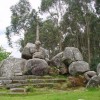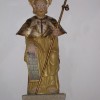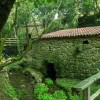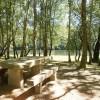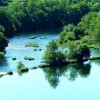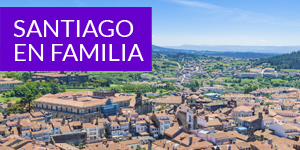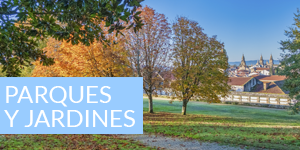- Accede I
- Regístrate I
- carrito
Área recreativa de Santiaguiño do Monte
Para llegar al área recreativa de Santiaguiño do Monte de Padrón tenemos dos opciones. La primera de ellas es ir a pie, a través de una escalera de 132 escalones que nacen muy cerca del Convento do Carme. La segunda posibilidad es llegar en coche, cogiendo la AC 299 en dirección a Rois, desviándonos a mano izquierda a unos 300 metros del puente de Santiago. Allí nos encontraremos un entorno incomparable para el descanso y el entretenimiento, ya que dispone de una zona acondicionada con mesas, parrillas, fuentes y parque infantil apta para el disfrute en familia o con amigos.
En el área se ubica la ermita del Santiaguiño. Se desconoce la fecha en la que se erigió, pero se sabe que en el siglo XV Rodrigo de Luna impulsa su reconstrucción.
INTERIOR DE LA ERMITA
En este lugar está el sepulcro del canónigo Gregorio, probablemente el constructor del templo, pues a partir del siglo XV el monte del Burgo comenzó a denominarse monte de San Gregorio, en honor al canónigo de Iria que reconstruyó la ermita con sus propios fondos y edificó casas para familias pobres, aunque no llegó a ver su proyecto acabado. Hasta la remodelación del templo, en 1960, el sepulcro se situaba en el centro de la ermita.
FUENTE
Este lugar se identificó con la gruta en la que se escondió el Apóstol Santiago y desde el siglo XV se vincula con el perdón de los pecados. Era el lugar donde bebían y se lavaban los peregrinos que se aproximaban al territorio en que el Apóstol predicó hace casi 2000 años.
La tradición popular transmitió la creencia de que la fuente era fruto de un milagro del Apóstol, quien hizo brotar agua de la roca al golpearla 3 veces con su báculo para saciar la sed de una gentil mujer.
Actualmente se mantiene el rito de recoger su agua en la víspera de San Xoán para que, mezclada con las hierbas, purifique y libre de los malos espíritus.
LAS ROCAS
En el centro del conjunto de los 10 grandes batólitos, destaca la figura de Santiago sobre una peana. Delante hay unas cruces grabadas y una inscripción que reza, según algunos, "Limosna para Santiago Maior Apóstolo" y, según otros, "Limosna para Jesús y María". En todo caso, al lado de esta debió de existir un peto. En la roca superior puede observarse una cruz pétrea que ya existía en el siglo XVII.
En el siglo XVI los peregrinos subían a estas rocas de rodillas rezando en cada uno de los escalones y terminaban el rito pasando a través de ellos. La creencia popular asegura que si no se recorren de vivo, ha de hacerse de muerto. Además, cada uno de los tres huecos recibe un nombre: infierno, cielo y purgatorio.
La tradición popular atribuye la formación de estos agujeros al Apóstol para librarse de sus perseguidores, asegurando que la piedra cedió para que Santiago pudiera esconder en ella su cabeza y su brazo derecho. Pero también hay quien afirma que se trata de las huellas de su caballo.
+info: www.terrasdeiria.com










